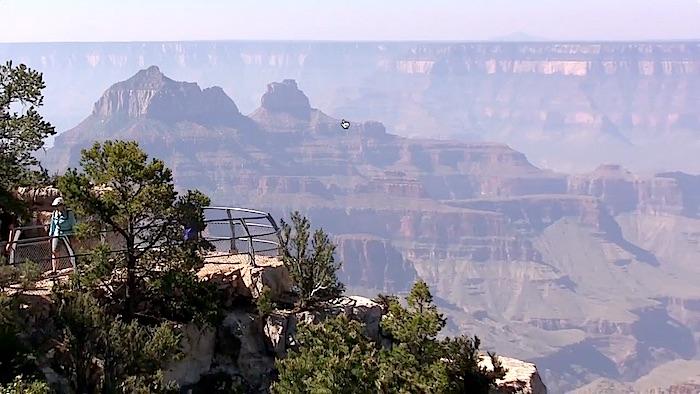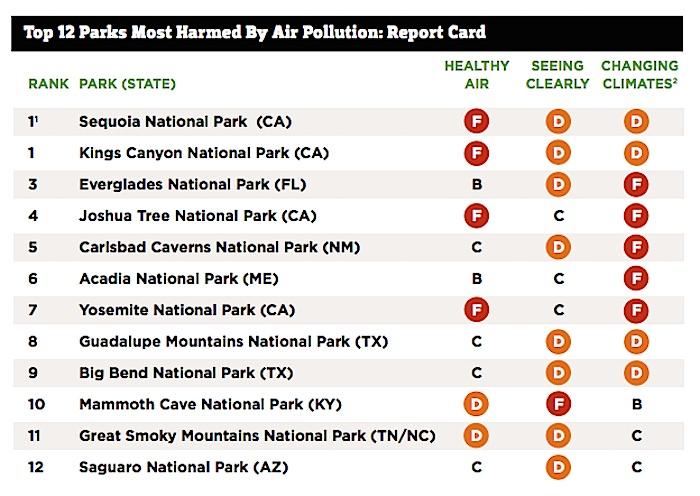
Hazy conditions often mar the view over Grand Canyon National Park. This shot was taken from the North Rim on Father's Day Weekend 2015/Kurt Repanshek
For many, a trip to one of the scenic, landscape national parks includes clear, pristine panoramas and fresh air. Unfortunately, we don't always get to enjoy those aspects, as a new report on air quality from the National Parks Conservation Association points out.
Pollution from power plants, industrial sites, traffic, and even agricultural operations continues to create problems with visibility and unhealthy ozone concentrations.
Air quality across the National Park System certainly can be a mixed bag. I’ve had spectacular days in the backcountry of Yellowstone and Rocky Mountain national parks, while a recent trip to the North Rim of Grand Canyon National Park was disappointingly hazy.
In their report, NPCA officials say that of 48 parks they studied, 36 at times experienced “moderate” or worse ozone pollution according to the Air Quality Index developed by the Environmental Protection Agency.
"These levels of air pollution are risky for especially sensitive populations such as children who have asthma (roughly one out of every ten children in the United States). Even more troubling, four parks—Joshua Tree, Sequoia, Kings Canyon, and Yosemite national parks—regularly had ozone levels that are known to be unhealthy for most park visitors," a release Tuesday from the park advocacy group said.
“As Americans flock to our national parks this summer to enjoy the great outdoors, they expect and deserve to find clean, healthy air. Sadly that is not always the case,” said Ulla Reeves, manager of NPCA’s Clean Air Campaign. “Our parks remain under threat from air pollution, harming visitors’ health, reducing visibility, and driving the impacts of climate change.”

Not too many hours after NPCA released its report, the National Association of Manufacturers issued a press release claiming that if the President Obama moves ahead with newly proposed regs pertaining to ozone emissions, "even some of our country's most iconic national parks will be considered in violation. If these pristine national treasures can't meet the new standard, how can any community expect to comply?"
NAM on Tuesday rolled out a television ad as part of a major advocacy campaign highlighting the negative impacts of the new proposed rule. This multimillion-dollar campaign is set to run over the next two weeks on cable and broadcast television.
"The President still has time to do the right thing for America's job creators and workers, and he can start by giving local communities the time and space they need to implement the current, and still relatively new, standard," said NAM President and CEO Jay Timmons. "Unfortunately, the new proposed ozone standard is so over the top, even places with no industrial activity for miles around will be considered noncompliant. There is a reason that hundreds of local and state officials and leaders from both parties and from across the country have stood up and spoken out on this critical issue. As their voices continue to amplify, it's a message that the President and the EPA won't be able to ignore."
According to NAM, many national parks, including the Grand Canyon, Zion and Yosemite, would be in nonattainment if the ground-level ozone standard, currently at 75 parts per billion averaged over an eight-hour period, was lowered to 70 parts per billion.
To help improve air quality, NPCA recommends that President Obama close loopholes in the Regional Haze Rule that states are supposed to follow in reducing pollution. Unfortunately, the report points out, "flaws in the Regional Haze Rule make it unlikely that the current approach will work. The rule doesn’t clearly lay out what pollution reduction options states need to consider or how they need to be weighed. So states can claim that reducing pollution is just too challenging while ignoring commonsense opportunities for progress. Flexibilities in the rule allow kicking deadlines down the road for generations to come."
Nebraska opted to allow its biggest polluter, Gerald Gentleman Station, to continue operating without basic emission controls, despite a clear demonstration of damage to Badlands and Wind Cave National Parks. If the Regional Haze Rule is not improved, in 50 years just 10 percent of national parks required to have clean air will actually have it.
NPCA also thinks the president should require the National Park Service to know "where pollution is coming from and how much it has to be limited to get to natural air quality. That information should determine pollution reduction requirements starting with targets for the next decade."
In a request likely to prove controversial, if not impossible to impose, the organization wants states to do their "share to clean up all the parks affected by its pollution—not just parks within its borders."
"Fortunately, this is one of those rare problems with a simple solution,” said Reeves. “With a stroke of the pen, the President can close the loopholes and make common sense revisions to ensure that states and the Environmental Protection Agency are poised in the coming years to restore dozens of our most treasured national parks to clear, healthy air.”
To keep tabs on air quality conditions at national parks, visit this National Park Service site that tracks ozone measurements across the park system.



Add comment